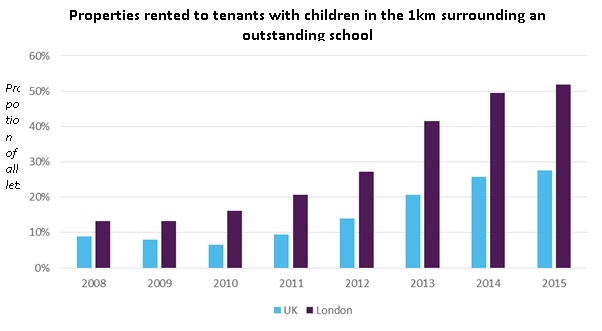Fierce competition for school places is speeding up the race for rental properties near the best schools in the country as well, new research from UK’s largest lettings agency Countrywide shows. The nation-wide proportion of properties located within 1 km of an OFSTED outstanding school and rented to families with children has increased to 28 per […]
Fierce competition for school places is speeding up the race for rental properties near the best schools in the country as well, new research from UK’s largest lettings agency Countrywide shows.
 The nation-wide proportion of properties located within 1 km of an OFSTED outstanding school and rented to families with children has increased to 28 per cent so far in 2015, from 26 per cent last year and from just 9 per cent in 2008, according to Countrywide’s Quarterly Lettings Index.
The nation-wide proportion of properties located within 1 km of an OFSTED outstanding school and rented to families with children has increased to 28 per cent so far in 2015, from 26 per cent last year and from just 9 per cent in 2008, according to Countrywide’s Quarterly Lettings Index.
In London, more than half of properties near top schools are rented by families with children now. While this is a product of the significant increase in competition for school places, the growing number of families living in the private rented sector means more of them move both for work and their children’s education, Countrywide says.
Families move mostly during the summer, from June to September, and they do not move far when they had found a place near an outstanding school. Usually the change of address is in just half a mile on average. This confirms the fine margins involved getting into school catchment areas. This distance is considerably shorter than the three miles the average households in the private rented sector moves.
As with house prices, tenants pay a premium to live close to a high performing school. Given tenants move more often than homeowners, this premium tends to be smaller. In 2015 the average tenant living within a kilometre of a school rated outstanding paid 14 per cent more than someone living more than a kilometre away. While the premium attached to one and two bedroom flats is almost negligible, tenants living in three or four bedroom houses pay an average of 16 per cent more. Where catchment areas are particularly tightly defined, a house on one side of the road can be let for 15-20 per cent more than an identical house on the other side.
Commenting David Fell, Research Analyst, Countrywide plc said:
“There are 1.6 million families with children living in the private rented sector, 20 per cent more than last year, which means school catchment areas are becoming increasingly relevant to the rental market. Many of these families are choosing to rent close to the school gates and in some cases parents are taking advantage of the flexibility of renting to move from the fringes of their preferred school’s catchment area to ensure their child’s entry.
“The flexibility of renting can present a challenge for schools, where competition for their places is high, particularly as some less scrupulous owners have in the past rented homes to try to secure a place in a school. Schools are becoming increasingly savvy now, ensuring the home is a family’s permanent residence rather than somewhere which has been rented for a few months during the application process.
“The growth of families with children renting is just one of the changes the sector will see as the number of renters in all different stages of life continues to grow. Adapting to provide for these changing needs is a big challenge for the sector.”

pro














